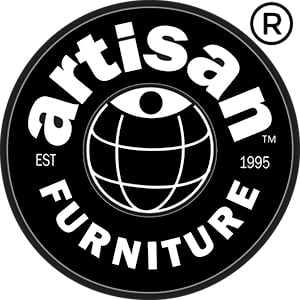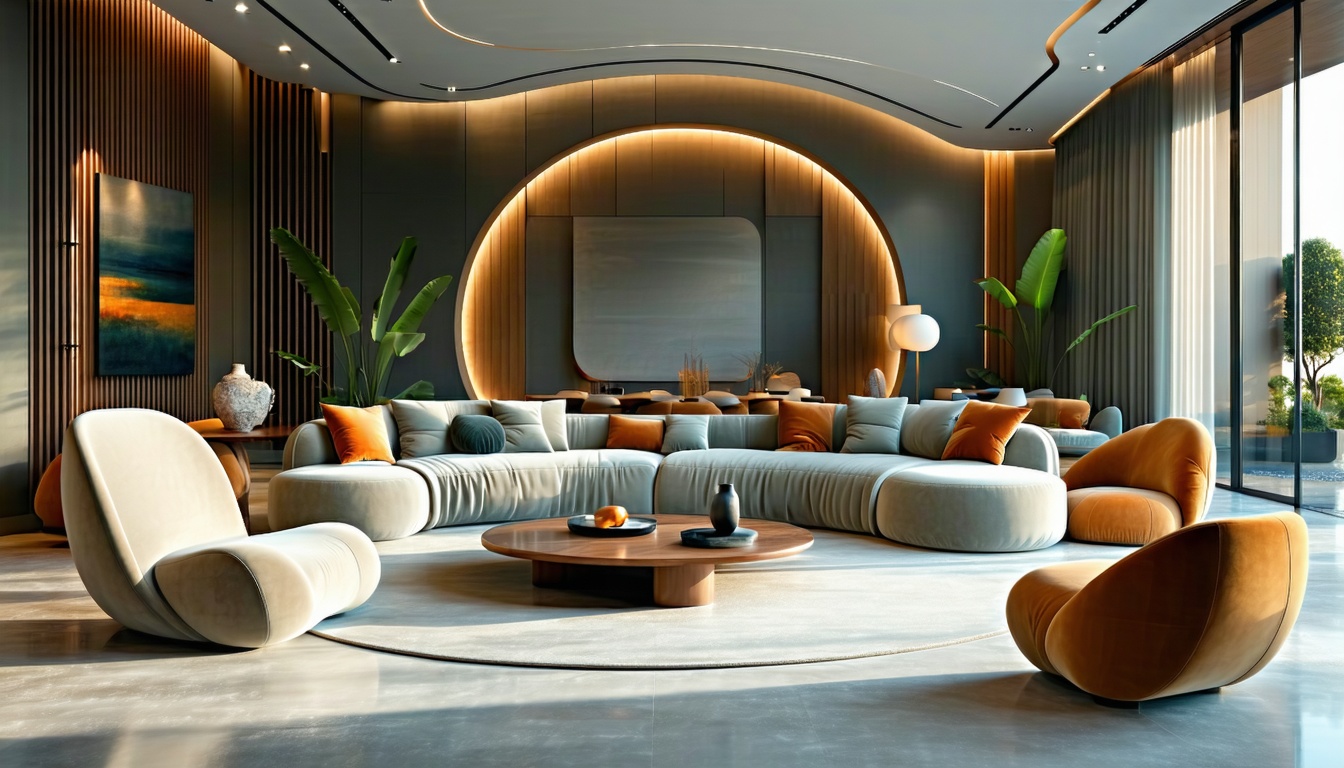Embracing Organic Shapes
Definition of Curved Furniture
Curved furniture refers to pieces that feature soft, rounded lines and organic shapes, departing from traditional straight-edged designs. This style has been gaining traction, showcasing a resurgence in popularity as homeowners seek unique curved furniture pieces that offer both aesthetic charm and functional utility. Recent years have seen a shift towards more sculptural alternatives, with curved furniture designs making a notable comeback in 2023 and beyond.
The defining characteristic of curved furniture is its graceful forms, which can include everything from gently rounded sofas to circular coffee tables. These pieces are designed to create a sense of flow within a space, enhancing the overall ambiance while serving practical purposes.
Appeal of Organic Designs
The appeal of organic designs in furniture lies in their ability to add elegance and sophistication to a room. Curved furniture designs are not only visually striking but also foster a more inviting and comfortable environment. Their smooth, rounded edges contribute to a relaxed atmosphere, making them a popular choice for modern living spaces.
Many homeowners find that these organic shapes help to create a seamless integration with various interior design styles, from contemporary to eclectic. Curved furniture enables better conversational arrangements in rooms, offering a cozy and accommodating space for gatherings.
| Feature | Benefits |
|---|---|
| Organic Shapes | Add elegance and sophistication to a space |
| Smooth Edges | Create a more inviting atmosphere |
| Enhanced Flow | Improve conversational spaces |
Incorporating unique curved furniture pieces can transform a home, turning it into a harmonious haven that prioritizes comfort and style. For those interested in exploring different ideas, a collection of curved furniture ideas is available to inspire the design journey. Whether considering contemporary options or sustainable curved furniture options, the versatility of organic furniture shapes offers a captivating approach to modern interiors.
Curved Furniture Trend
Curved furniture is emerging as a prominent trend, offering both aesthetic appeal and functional benefits. Designers highlight that organically-shaped pieces provide a modern yet timeless feel to homes, fitting seamlessly into various layouts.
Integrating Curved Pieces
Curved furniture is visually appealing, adding an element of softness and sophistication to a space while being extremely versatile for use in both traditional and contemporary settings. Popular choices include curved sofas, round coffee tables, and soft-edged chairs. These unique curved furniture pieces contribute to creating a more inviting and comfortable environment, making them a worthwhile consideration for updating a home’s interior.
When integrating curved pieces, consideration should be given to the layout of the space. Curved furniture can enhance conversational areas, creating a dynamic atmosphere conducive to socializing. It can also soften the look of a room filled with angular furniture, delivering a balanced aesthetic in design.
| Furniture Type | Description |
|---|---|
| Curved Sofas | Sofas with gentle curves for comfort and style |
| Round Coffee Tables | Tables that eliminate sharp edges, enhancing flow |
| Soft-Edged Chairs | Chairs designed for comfort with a modern twist |
For more design ideas, explore our resources on curved furniture ideas and modern curved furniture designs.
Benefits of Curved Furniture
Curved furniture offers significant psychological benefits, as they are perceived as softer and safer compared to angular designs. This characteristic leads to spaces that feel more relaxing and stress-free. Curved pieces can help reduce stress and anxiety, making them suitable for wellness-focused home interiors and modern workplaces prioritizing wellbeing.
Additionally, curved furniture enhances the flow of space by encouraging movement and guiding the eye smoothly around a room. This creates a sense of continuity and openness, which can maximize seating arrangements in both small apartments and large open spaces. The effectiveness of curved furniture is particularly notable in compact space design, where optimization is key.
The trend towards nature-inspired furniture design aligns with the resurgence of curved furniture, highlighting how organic shapes can foster a harmonious living environment. Sustainable options for curved furniture also allow homeowners to make eco-conscious choices while embracing this stylish trend. For more insights, check out our article on sustainable curved furniture options.
Designers and Materials
In the realm of curved furniture design, several key players and innovative materials are shaping the landscape. Designers are emphasizing organic shapes that offer both aesthetic appeal and functional benefits, making these pieces integral to modern interiors.
Kin & Company Creations
Kin & Company, a Brooklyn-based design studio run by cousins Kira de Paola and Joseph Vidich, specializes in crafting unique curved furniture pieces. Known for their statement-making and curvilinear forms, Kin & Company combines artistry with practicality. Their designs not only enhance the visual appeal of a space but also contribute to the overall comfort and functionality of the environment. By focusing on fluid lines and inviting silhouettes, they create furniture that promotes a relaxed atmosphere.
| Designer | Specialization | Notable Features |
|---|---|---|
| Kin & Company | Curvilinear forms | Statement pieces with organic shapes |
Innovation in Materials
The furniture design industry is witnessing a bold trend toward the integration of diverse and sustainable materials. In 2025, the use of stone materials like marble and granite is expected to be prominent, showcasing a sophisticated blend of natural forms and enduring textures. This shift towards using luxurious materials is ideal for creating statement-making interiors that are both functional and visually striking.
Additionally, there is a significant emphasis on sustainable materials in curved furniture design. Nina Lichtenstein advocates for incorporating eco-friendly elements, such as reclaimed wood and recycled metals, to foster a rustic ambiance while prioritizing environmental sustainability. By combining sustainability with creativity, designers are not only enhancing the beauty of their pieces but also contributing positively to the environment. For those interested in exploring more options, check out our article on sustainable curved furniture options.
The focus on unique materials and innovative designers reflects the ongoing evolution of furniture, transforming living spaces into modern, functional, and alluring environments. Homeowners looking to elevate their interiors can explore various curved furniture ideas that fit seamlessly into different layouts and styles.
Crafting Curved Furniture
Creating unique curved furniture pieces involves specialized techniques that allow designers to shape materials into flowing, organic forms. Mastering these methods is essential for producing aesthetically pleasing and functional pieces that enhance modern living spaces.
Techniques for Curved Parts
Several techniques are used to craft curved furniture, each offering different benefits suited to various design preferences and material types.
| Technique | Characteristics | Pros | Cons |
|---|---|---|---|
| Sawing | A straightforward method for cutting curves into wood. It allows for various shapes and different curves on opposing sides. | Quick and versatile; suitable for different thicknesses. | Can be less precise for intricate designs. |
| Bent Lamination | Involves layering thin strips of wood and gluing them together to create strong, stable curves. | Produces lightweight pieces with a grain that follows the curve; allows for fine detailing. | Exposed glue lines can affect aesthetics. |
| Steam-Bending | A process that softens wood with steam, allowing it to be bent without the use of glue or laminates. | Provides a natural appearance without glue lines; efficient for reproducing parts. | Requires the setup of steaming equipment. |
Sawing, Laminating, Steam-Bending
Sawing is the simplest and fastest method to produce curves in wood. It is suitable for creating curves in stock of virtually any thickness, making it ideal for various designs. The bandsaw is the primary tool used for sawing curves, offering craftsmanship flexibility.
Bent Lamination is conducive to producing the strongest and most stable curved furniture parts. This technique allows for the creation of thin, lightweight options that maintain strength while showcasing grain patterns that follow the curves. However, it can leave visible glue lines, which might detract from the overall visual impact of the furniture.
Steam-Bending remains a favored technique for creating curved components. When the wood is steamed, the grain follows each curve closely, providing a seamless and natural look. This method is often quicker and less expensive for reproducing parts once the steamer is set up and the forms are created. Steam-bending produces clean lines without additional glue, making it a favored choice for nature-inspired furniture design.
By employing these techniques, artisans can craft unique curved furniture pieces that embody both creativity and functionality, seamlessly fitting into modern living spaces. For more inspiration, check out our curved furniture ideas or explore sustainable curved furniture options.

